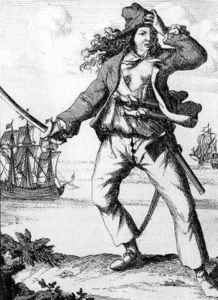by Sue Jones. Sue has taught at Birkbeck, University of London, and University of Plymouth. She lives a double life, researching seventeenth century piracy and working in the Gingerbread advice team.
It is often difficult to discover the lives of single parents in history, particularly those who were poor and illiterate. As they could not write themselves, we must look between the lines of historical documents for traces of them. Sometimes we find a glimpse of their lives in the stories of their children.

In September 1720 news broke of a pirate attack on shipping in Providence, America. Piracy was common in the eighteenth century, but this incident was remarkable as the pirate crew included two women.
Anne Bonny and Mary Read, rumoured to be lovers, became infamous and were much written about. As a result, we know more about their lives than those of many poor women. The story of Mary Read’s childhood in particular highlights the financial struggles and choices faced by parents trying to bring up their children alone.
Mary Read’s mother was married to a sailor, and they had a son together. She was widowed when her husband was lost at sea. When she later became pregnant, she left her home to hide her condition from her husband’s relatives and went to stay with friends in the countryside. She gave birth to Mary around 1695, concealing the birth from her husband’s family.
When her son died, Mary’s mother was faced with the prospect that she and her daughter would be on the streets as her husband’s family would no longer provide her with support. She decided not to tell them her son had died and to pretend that Mary was her son to get financial help from her mother-in-law. She dressed Mary as a boy and her mother-in-law agreed to provide a crown a week (the equivalent today of around thirty pounds a week) as maintenance for the child. Mary was 13 when the mother-in-law died, but she continued to pass as a boy and found work as a footman.
Mary tired of being a servant and, dressed as a man, travelled to Flanders where she joined the army and fought in several battles. She fell in love with a fellow soldier, and they married and ran a tavern together. When her husband suddenly died, Mary assumed men’s clothing once again and boarded a ship to the West Indies. When the ship was captured by pirates, Mary decided to join them. After a short career of piracy, she was captured as part of pirate captain Jack Rackham’s crew along with Anne Bonny who also dressed as a man.
On 28 November 1720 the two women were found guilty of piracy and sentenced to hang but both were found to be pregnant and escaped the death penalty. Mary, however, died in prison a few months later and was buried in Jamaica on 28 April 1721.
Mary had a short and difficult life marked by death, poverty and violence. At a time when there was no welfare state her mother made the decision to disguise her as a boy for financial reasons and, in a time of few opportunities for women, provided the possibility of a new and radically different life for her daughter.

